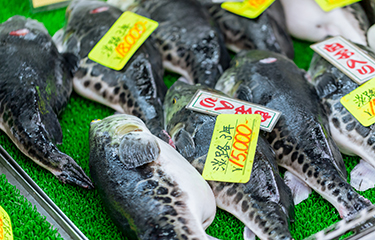Japan has plans to increase exports of fugu (blowfish, pufferfish) by creating a standard nationwide test to license those who process it, replacing the current mish-mash of prefectural regulations.
The lack of national involvement in the regulations has been been viewed as an obstacle to exporting the blowfish to some foreign countries, many of which are reluctant to import the fish on safety grounds. Famously fugu, depending on the species, can be highly poisonous, with the skin, liver, and ovaries all potentially being lethal if prepared incorrectly.
Despite its reputation as dangerous, the number of people who die from blowfish poisoning every year in Japan is small, typically ranging from zero to three. Most of those incidents are from sport fishermen who attempt to prepare their catch at home. For example, in 2017, there were 19 poisoning incidents (17 at home) involving 22 people (20 at home), and no one died.
Previously, licensing requirements were not national, but varied prefecture by prefecture. Of Japan’s 47 prefectures, 19 (including Tokyo) had required establishments serving blowfish to hire chefs that had obtained a blowfish-preparation license. Some prefectures required up to three years of experience as an apprentice, while others required only one.
In Tokyo, obtaining the license required a two-year internship and a test. But since 2012, that license was only required when the fish is processed on site, such as at restaurants displaying live fish in tanks.
Shops and restaurants without certified blowfish chefs had to display a sign showing they only serve “migaki fugu,” which is blowfish with the poisonous body parts removed, and processed blowfish, which is further cut into pieces. The fish had to be certified and labeled and the operators had to keep sourcing records and report to the metropolitan government. The 2012 change was prompted by growing internet sales, as blowfish prepared in one area was sent by refrigerated courier to others.
The new rule scraps the apprenticeship requirement in favor of a workshop, and standardized testing of skills and knowledge. It also specifies what areas of knowledge should be tested. Those who pass the test should be able to work in any prefecture.
The new regulation was promulgated by the Ministry of Health, Labor and Welfare at the end of October last year. The Ministry is also supposed to evaluate how well municipalities are integrating the new policy into their local rules, and publish the results later this year. The actual inspection of facilities usually falls to municipalities, rather than prefectures.
The Ministry will also issue regular updates about hybridizations, which are likely to be an increasing problem amid global warming.
The spottyback puffer from the Sea of Japan has now crossed through the Straights of Tsugaru separating Honshu and Hokkaido Islands and moved into the Northeast Pacific – possibly facilitated by warmer ocean temperatures that allowed it to extend its range northward. It is now hybridizing with the pear puffer in the new region.
A study analyzed the DNA of pear puffers off NE Japan from 2012 to 2015 and found that over half of the samples were hybrids. As the species of the hybrids cannot be clearly identified – and thus determining which parts are poisonous cannot be done – they are discarded.
As for the current export market for Japanese blowfish, the Tokyo-based International Fugu Association noted in a previous report that in countries that ban blowfish imports, such as in the E.U. and Taiwan, there is no domestic system for regulating blowfish, so it may not be possible for them to overcome concerns about food poisoning, due to both the distribution of poisonous blowfish from countries other than Japan, and Japan’s system of different regulations for each local government. The unifying of Japan’s regulations should help to overcome the latter issue.
Countries that currently allow imports from Japan are Malaysia, the U.S., Russia, and Singapore. Much of the association’s marketing efforts are now concentrated on Singapore.
Hong Kong and Taiwan have been discussing allowing imports, but still maintain bans. Regarding the export of blowfish, the new regulation states that when the country holds talks with export destination countries to try to lift an import ban on blowfish, the Japanese government will specify specific blowfish processors that meet the certification criteria of the export destination country.
Photo courtesy of Quality Stock Arts/Shutterstock







